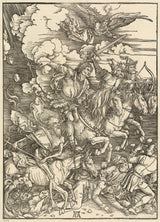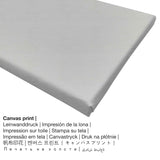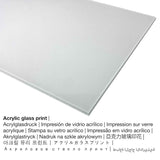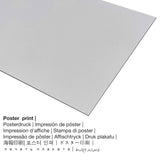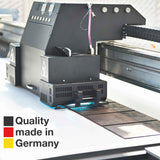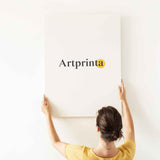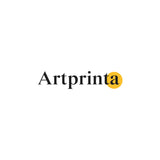Albrecht Dürer, 1498 - Ndị na-agba ịnyịnya anọ - mbipụta nka mara mma
Ụtụ gụnyere. Mbupu gbakọrọ na ndenye ọpụpụ.
Summary
In 1498 Albrecht Dürer created this artpiece "The Four Horsemen". Ihe osise a bụ nke mkpokọta nka Nnukwu osisi nke Art, which is the museum of the US-American nation that preserves, collects, exhibits, and fosters an understanding of works of art. With courtesy of - National Gallery of Art, Washington (public domain).The creditline of the artpiece is the following: . Furthermore, alignment is in Eserese usoro na nha onyonyo nke 1: 1.4, nke pụtara na ogologo bụ 29% mkpụmkpụ karịa obosara. Albrecht Dürer was a painter from Germany, whose style can primarily be classified as Northern Renaissance. The European artist lived for a total of 57 afọ - amuru n'ime 1471 and passed away in the year 1528 in Nuremberg.
Additional information on the original artwork by National Gallery of Art (© - by National Gallery of Art - Nnukwu osisi nke Art)
Medium: Woodcut on laid paper
Dimensions: Plate: 39.5 x 28.5 cm (15 9/16 x 11 1/4 in.) Sheet: 45.7 x 31.5 cm (18 x 12 3/8 in.)
This is one of Albrecht Dürer's most famous woodcuts. It depicts the four horsemen said in the Book of Revelation to hail the end of the world: Death, Famine, War, Plague (from left to right). Note that the horsemen are trampling all men beneath them, including a king; this serves as a reminder not to be too vain or proud, for death, destruction and judgement will eventually come to all.
( Ederede: Emily Wilkinson )
Ozi ndabere na nka pụrụ iche
| Aha eserese: | "The Four Horsemen" |
| Nhazi nka nka: | sere |
| Otu sara mbara: | nka ochie |
| Nhazi oge: | 15th narị afọ |
| Ekepụtara: | 1498 |
| Afọ nka: | 520 afọ |
| Ụlọ ihe ngosi nka / ebe: | Nnukwu osisi nke Art |
| Ebe ngosi nka: | Washington DC, Njikota Obodo Amerika |
| Weebụsaịtị ihe ngosi nka: | www.nga.gov |
| Ụdị nka nka: | ngalaba ọha |
| Site n'aka: | National Gallery of Art, Washington |
Banyere omenka
| Aha onye nka: | Ọ bụ Albrecht Dürer |
| Gender: | nwoke |
| Obodo onye nka: | German |
| Ọrụ: | onye na-ese ihe |
| Country: | Germany |
| nhazi ọkwa: | nna ukwu ochie |
| Ụdị nke onye na-ese ihe: | Northern Renaissance |
| Nwụrụ na afọ nke: | 57 afọ |
| Afọ ọmụmụ: | 1471 |
| Afọ nwụrụ: | 1528 |
| Nwuru na (ebe): | Nuremberg |
Ngwa ngwaahịa a na-ahọpụta
Anyị na-enye ụdị dị iche iche nha na ihe maka ngwaahịa ọ bụla. Ka ị kwekọọ n'ihe ị chọrọ nke ọma, ị nwere ike họrọ n'ime nhọrọ nhazi ngwaahịa ndị a:
- Mbipụta akwụkwọ mmado (akwa akwa akwa): A poster print is a printed flat canvas with a slight surface finish. Please note, that depending on the size of the poster print we add a white margin of around 2-6cm round about the painting to facilitate the framing with your custom frame.
- Mbipụta iko acrylic (nke nwere ezigbo mkpuchi iko): The acrylic glass print, which is often labelled as a an art print on plexiglass, will change the original into great wall décor. Moreover, the acrylic art print offers a good alternative option to dibond and canvas prints. Your own replica of the work of art will be manufactured with the help of modern UV direct printing technology. Our plexiglass with real glass coating protects your chosen art print against sunlight and external influences for decades.
- Kwaaji: The printed canvas material mounted on a wooden frame. It has the distinctive look of three-dimensionality. Further, a canvas makes a nice, comfortable feeling. The advantage of canvas prints is that they are relatively low in weight, which means that it is quite simple to hang the Canvas print without additional wall-mounts. Because of thatcanvas prints are suitable for all types of walls.
- Aluminom dibond mbipụta (ọla): This is a metal print made on aluminium dibond with an outstanding depth, creating a contemporary look throuch a surface structure, that is not reflective. For our Aluminium Dibond print, we print the artwork on the aluminium surface. The UV print on Aluminum Dibond is the most popular entry-level product and is a stylish way to showcase art prints, since it draws focus on the artwork.
Nkọwa ngwaahịa
| Bipụta ụdị ngwaahịa: | nka nka |
| Usoro mmeputakwa: | dijitalụ mmeputakwa |
| Usoro mmepụta: | UV kpọmkwem obibi |
| Mmalite nke ngwaahịa a: | emepụtara na Germany |
| Stockdị ngwaahịa: | na mmepụta ihe |
| Ihe eji eme atụmatụ: | foto mgbidi, nka mgbidi |
| Ndepụta: | nhazi ihe osise |
| Oke akụkụ: | 1: 1.4 |
| Mmetụta akụkụ onyonyo: | ogologo bụ 29% mkpụmkpụ karịa obosara |
| Ụdị ihe dị iche iche: | Mbipụta kwaaji, mbipụta enyo acrylic (nwere ezigbo mkpuchi iko), mbipụta akwụkwọ mmado (akwụkwọ kwaaji), mbipụta ọla (aluminium dibbond) |
| Mbipụta kanvas (akwa akwa na etiti ihe ndọtị): | 50x70cm - 20x28" |
| Mpempe iko acrylic (nwere ezigbo mkpuchi iko) nha: | 50x70cm - 20x28" |
| Mpempe akwụkwọ mmado (akwụkwọ kwaaji) nha dị iche iche: | 50x70cm - 20x28" |
| Mpempe akwụkwọ Dibony (ihe alumnium) nha: | 50x70cm - 20x28" |
| Nhazi mbipụta nka: | na-enweghị etiti |
Ozi dị mkpa: We try whatever we can to describe the products as accurate as possible and to demonstrate them visually on the product detail pages. Although, the pigments of the printed materials, as well as the printing may vary slightly from the presentation on your device's monitor. Depending on the screen settings and the quality of the surface, not all color pigments can be printed as realisitcally as the digital version depicted here. In view of the fact that the fine art prints are printed and processed by hand, there might as well be minor differences in the size and exact position of the motif.
Copyright right, Artprinta.com (Artprinta)

